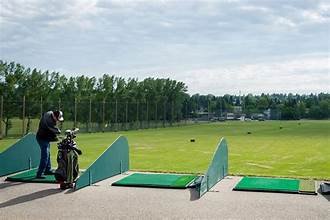Life Is a Golf Course: Lessons from the Fairway to the Final Hole
At first glance, golf might seem like nothing more than a game involving clubs, balls, and well-manicured greens. But look closer, and you’ll discover something far deeper — a quiet reflection of life itself. With every swing, golf teaches us patience, persistence, and the ongoing journey of self-awareness.
Interestingly, a standard 18-hole round of golf has a total par of 72 — closely mirroring the average human lifespan. If we view each hole as representing four years of life, the entire course becomes a symbolic journey from birth to the age of 72. This comparison offers a unique and thoughtful way to reflect on how the game of golf mirrors the different stages of a healthy, meaningful life.
Where Golfers Are Born: The Range as a Womb
Practicing golf at the range is much like the time a baby spends in the mother’s womb — a quiet, essential phase of preparation. Just as it takes nine months for life to take shape before entering the world, a beginner golfer needs that same period to build the basics, develop rhythm, and gain confidence before stepping onto the course. It’s hidden work that makes the visible journey possible.


The first hole represents the early childhood years, from birth to age four. Just as a child is entirely dependent on the mother’s care and protection during this phase, the first shot — the tee-off — relies heavily on the Driver, the club that provides maximum support and direction to begin the journey. Both moments are filled with anticipation, hope, and possibility. The direction you take at the start can set the tone, but it rarely decides the whole journey.
Hole One: The Protected Beginning


Hole Two: Finding Direction with Gentle Guidance
The second hole symbolizes the age span of 4 to 8 years — a formative phase when a child begins to explore the world beyond the mother’s arms. It’s a time of growing curiosity, tentative steps, and early learning. The child starts seeking direction, trying to walk without stumbling, and needs steady guidance to stay on course. Similarly, in golf, after the tee shot, the ball must be kept in the fairway with well-chosen, more precise clubs. Just as a child requires nurturing and encouragement to find balance, the ball too needs skillful handling to stay aligned with the target. This stage sets the foundation for control, confidence, and course awareness — in both life and golf.
Hole Three: The Age of Awareness and Expectation
The third hole mirrors the stage of life between 8 to 12 years — a time when a child begins to develop a sense of self, along with the ability to express opinions, make small demands, and understand expectations. This period marks the transition from simple obedience to independent thought. Just as the fairway on Hole Three starts to demand accuracy and control, life at this stage expects the child to stay within certain boundaries while still exploring their capabilities. In golf, keeping the ball in the center of the fairway is crucial to setting up the next shot effectively. Similarly, a child needs the right environment, structure, and gentle discipline to stay on course, preparing them for the more complex stages that lie ahead.
Hole Four: The Age of Competition and Course Correction
The fourth hole represents the adolescent years between 12 and 16 — a phase when the child begins to step into a more competitive world. This is the age where comparisons emerge, and academic or extracurricular rivalries among peers start to take shape. The need to prove oneself, to stand out, and to learn from both success and failure becomes more prominent. In golf, Hole Four is often when players in a group start observing each other more keenly — noting mistakes, analyzing strengths, and silently adjusting their own game based on what they see. Similarly, during this life stage, young minds become more aware of their surroundings, take cues from others, and begin the process of internal course correction. It’s not just about playing your shot anymore; it’s about understanding the dynamics of the group, learning from others, and making mindful adjustments to grow and compete better.
Holes Five to Eight: Navigating Challenges and Stepping into Adulthood
Holes five through eight on the golf course symbolize the transformative years of life between the ages of 16 and 30. Much like a course that winds through bunkers, water hazards, and tight fairways, this phase is filled with trials, transitions, and defining moments. It begins with the intense pressure of academic milestones, competitive exams, and the early steps into the professional world.
During this period, youth begins to shift gears — from impulsive to intentional. With experience and exposure, they become more focused, mature, and measured in their actions. Just as a golfer carefully chooses between long drives and delicate chips to stay on the green, a young adult learns to balance ambition with caution. Rash decisions give way to thoughtful planning. The emotional turbulence of adolescence settles into a calmer, goal-driven rhythm.
By the end of this stretch, many have found a foothold — completing their education, clearing tough competitions, landing their first jobs, and even beginning to shoulder financial responsibilities. Like a golfer who has adapted to the course and is now playing with clarity and control, the young adult stands ready to face the broader game of life with growing confidence.
Holes Nine to Twelve: Mastery, Responsibility, and Guiding the Next Generation
Holes nine through twelve mark a significant phase in a golfer’s journey — a stage where the player not only understands the course intimately but has also developed the maturity, skill, and confidence to navigate it with precision. By this point, the golfer plays not just with technique, but with experience. Hazards are no longer intimidating but are approached with strategy. Lofty drives, accurate approaches, and confident putts reflect a sense of command — much like a seasoned course manager who knows every inch of the terrain.
This stage beautifully parallels the age span of 30 to 60 in a person’s life — the prime years of productivity, leadership, and fulfillment. It’s a time when an individual has carved out a respectable identity, achieved professional stability, and is focused on nurturing and supporting their family. They are no longer just players in the game of life — they are mentors, guiding the next generation with wisdom. Much like introducing their children to golf, they teach the values of discipline, balance, and grace — on the course and in life. These holes symbolize the calm confidence of a well-earned position, where challenges are met with poise, and success is defined not only by personal achievement but also by the legacy being shaped.
Holes Thirteen to Eighteen: The Final Stretch with Grace and Reflection
The final six holes of a golf round — 13 to 18 — beautifully mirror the later stage of life, from age 60 to 72. This is the closing stretch, where the golfer moves across the course with quiet pride, having navigated challenges and played the game with purpose. There’s a sense of fulfillment in the air, along with anticipation for the closing ceremony that follows the round — much like a person approaching retirement, reflecting on a life of effort and achievement.
At this stage, the focus shifts from ambition to reflection. The individual begins planning for retirement benefits, managing the corpus built over the years, and thinking about how to remain mentally and emotionally engaged after stepping away from active work life. Just as a golfer paces the final holes with care and composure, the retiree considers new roles, hobbies, or contributions — preparing for a meaningful life beyond 72, filled with purpose and peace.
Conclusion
In conclusion, I truly believe that to make life sweeter, more meaningful, and enjoyable, one should continue playing golf for as long as possible — even into the final chapter of life. For those who may not know, I picked up the golf club for the first time at the age of 72, and it has given me a renewed sense of purpose and joy. I invite you to read more about this transformative journey in my blog: “Swinging into Retirement: My Journey Into Golf at 72.”
The crown jewels of the golfing world are scattered across breathtaking landscapes, each with its own history, charm, and challenge. Leading the list is the legendary Royal County Down in Northern Ireland, where the rugged mountains meet the Irish Sea. Next comes Royal Dornoch in Scotland, a timeless masterpiece steeped in tradition. No golfing journey is complete without The Old Course at St. Andrews — the very birthplace of the game. Across the Atlantic, Pine Valley Golf Club in the United States stands as a benchmark for course design and difficulty. Completing this elite list is Muirfield in Scotland, known for its strategic layout and prestigious championships. Together, these five courses form the ultimate pilgrimage for golfers worldwide.
The top five most famous golf championships in the world are:
The Masters Tournament – Held annually at Augusta National Golf Club in Georgia, USA, known for its iconic green jacket and pristine course conditions.
The Open Championship (British Open) – The oldest golf tournament in the world, played on historic links courses across the United Kingdom.
The U.S. Open – A true test of skill and endurance, played on some of America’s toughest and most challenging courses.
The PGA Championship – Known for attracting the strongest field in golf, with venues rotating among top U.S. courses.
The Ryder Cup – A thrilling team competition between Europe and the United States, held every two years, celebrated for its passion and national pride.
